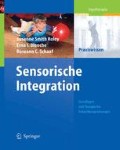Zusammenfassung
In diesem Kapitel wird überdaszunehmend umfassendere Wissen über sensorische Verarbeitungsdefizite bei zerebralparetischen Kindern berichtet, und es werden spezifische Techniken dargestellt, mit denen diesensorisch-integrativen Defizite dieser Kinder behandelt werden können.
Access this chapter
Tax calculation will be finalised at checkout
Purchases are for personal use only
Preview
Unable to display preview. Download preview PDF.
References
Fisher, A. (1991). Vestibular-proprioceptive processing and bilateral integration and sequencing deficits. In A.G. Fisher, E.A. Murray, und A.C. Bundy (Eds.), Sensory integration: Theory and practice (pp. 71–107). Philadelphia: F.A. Davis.
Fisher A. (2002) Defizite der vestibulär-propriozeptiven Verarbeitung, der bilateralen Integration und des Seqenzierens. In: A. Fisher, E. Murray, and A. Bundy (Hrsg) Sensorische Integrationstherapie. Theorie und Praxis. 2. Aufl. Springer Berlin Heidelberg New York
Hyiton, N., und Allen, C. (1997). The development and use of SPIO Lycra compression bracing in children with neuromotor deficits. Pediatric Rehabilitation, 7(2), 109–116.
Kenney, W.E. (1963). Certain sensory defectsin cerebral paisy. Clinical Orthopedics 27, 193–195.
Lesny, I., Stehlik, A., Tomasek, J., Tomankova, A., und Havlicek, I. (1993). Sensory disorders in cerebral palsy:Two-point discrimination. Developmental Medicine and Child Neurology, 35, 402–405.
Moore, J. (1984, May). Theneuroanatomyand pathology of cerebral palsy. In Selected Proceedings from the Barbro Salek Memorial Symposium, 3–60.
New York City Occupational Therapists. (1953). Feeding suggestions for the training of the cerebral palsied. The American Journal of Occupational Therapy, 7(5), 199–204.
New York City Occupational Therapists. (1954). Dressing techniques for the cerebral palsied child. The American Journal of Occupational Therapy, 8(1), 8–11.
Parham, J.D., und Ecker, G. (2000). Evaluation of Sensory Processing (ESP-V4). Unpublished manuscript.
Robinault, I.P. (1953). Occupational therapy techniques for the preschool hemiplegie-Toys and training. The American Journal of Occupational Therapy, 7(5), 205–207.
Robinault, L.P. (1954). Perception techniques for the preschool cerebral palsied. The American Journal ofOccupational Therapy, 8(1), 3–7.
Sugden, D.A., und Keogh, J.F. (1990). Cerebral palsy. In H.G. Williams (Ed.), Problems in movement skills development: Growth, motor development and physical activity across the life span (pp. 1–39). Columbia, SC: University of South Carolina Press.
Thibault, A., Forget, R., und Lambert, J. (1994). Evaluation of cutaneous and proprioceptive sensation in children: A reliability study. Developmental Medicine and Child Neurology, 36, 796–812
Van Heest, A.E., House, J., und Putnam, M. (1993). Sensibility deficiencies in the hands of children with spastic hemiplegia. The Journal of Hand Surgery, 18(2), 278–281.
Wann, J. (1991). The integrity of visual-proprioceptive mapping in cerebral palsy. Neuropsychoiogia, 29(11), 1095–1106.
Windsor, M.M. (1986). Incorporating sensory integration principles into treatment of children with cerebral palsy. American Occupational Therapy Association Developmental Disabilities Special interest Section Newsletter, 9, 3–4.
Yekutiel, M., Jariwala, M., und Stretch, P. (1994). Sensory deficits in the hands of children with cerebral palsy: A new look at assessment and prevalence. Developmental Medicine and Child Neurology, 36, 619–624.
Zimmerman, M.E. (1957). Analysis of adapted equipment. The American Journ al of Occupational Therapy, 11(4), 229–235.
Rights and permissions
Copyright information
© 2004 Springer-Verlag Berlin Heidelberg
About this chapter
Cite this chapter
Imperatore Blanche, E., Nakasuji, B. (2004). Sensorische Integrationstherapie bei Kindern mit Zerebralparese. In: Sensorische Integration. Springer, Berlin, Heidelberg. https://doi.org/10.1007/978-3-642-18867-1_16
Download citation
DOI: https://doi.org/10.1007/978-3-642-18867-1_16
Publisher Name: Springer, Berlin, Heidelberg
Print ISBN: 978-3-540-00093-8
Online ISBN: 978-3-642-18867-1
eBook Packages: Springer Book Archive

